Wild, Wild East
Earlier on the trip, I read Dave Eggers' book You Shall Know our Velocity, and one of the characters commented a somewhat disappointing truth: that within the United States, you can find the vast majority of the world's natural scenery. Other than the rice terraces in Southeast Asia, deep fjords in Norway, and curvy mountains of Halong Bay in Vietnam and Guilin in China, I struggle to think of areas which don't have a fairly close match within the US.
Turkey's Cappadocia region is one of those few places.
Cappadocia is a collection of towns and villages famous the world over for its bizarre collection of houses and churches carved into naturally-occurring rock spires. I arrived in Goreme, a popular base for backpackers exploring the area, where I met up with my French Canadian friend Emmanuel who I met earlier in Turkey. We spent the day getting a feel for the great village atmosphere of Goreme, which retains a ton of charm despite its popularity. Many people still get around town by tractor or horse cart, despite cars and motorbikes now being the norm. Men gathered at a popular outdoor tea garden to chat and play endless games of backgammon and Turkish dominoes, and it seemed like every woman in town spent most of the day sitting outside the doors to their houses watching the world go by.
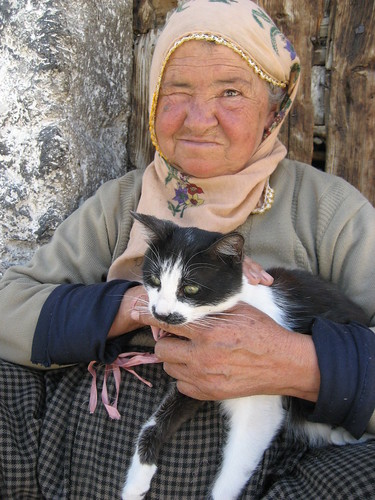
Scattered throughout the town of Goreme are hundreds of massive stalagmite-like rocks which blend seamlessly into homes, then back into rocks, then back into homes. Sometimes it was hard to tell what was natural and what was man-made. Although most caves in the area where abandoned by order of the government in the 1950s, many of the cave houses in Goreme are still functioning homes or hotels. My great hostel was among them, and for around seven bucks a day, I was able to sleep in a hand-dug cave room and enjoy a great breakfast each morning in the courtyard. It looked a lot like Uncle Owen and Aunt Beru's family home on Tatooine from the original Star Wars film, which greatly pleased my inner-nerd.*
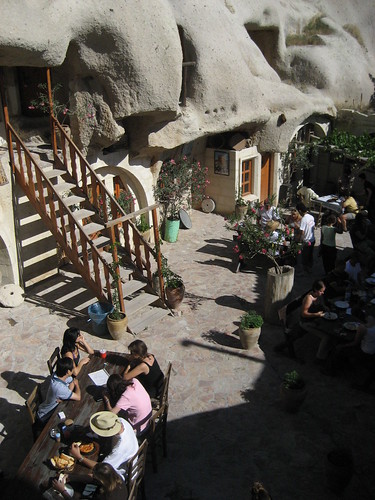
*In case anyone cares, travelers are able to stay the real filming location that served as Luke Skywalker's aunt and uncle's home — Hotel Sidi Driss located in Matmata, Tunisia. I'm so awesome that I didn't even have to look that up. Did you hear that, ladies? Didn't even have to look it up. I also collect action figures. Call me.
Emmanuelle and I walked a few miles from town to the Goreme Open-Air Museum, which is a collection of impressive Byzantine cave churches carved into existence between 700 and 900. Despite their small size, the churches were absolutely amazing, and were full of original great folksy-looking frescoes painted onto the wall. We spent a few hours at the museum, wandering among the churches and monasteries before Emmanuelle caught a bus to start her journey back to Montreal. Here is the tallest of the cave structures and one of the brilliant fresco paintings inside:
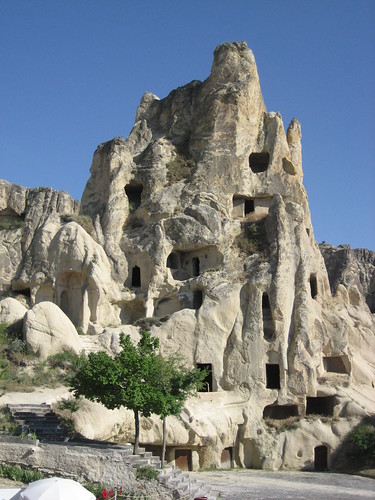
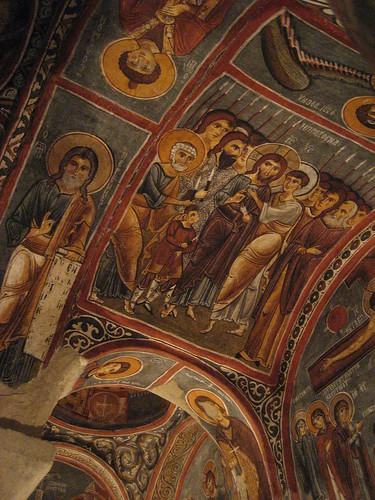
I spent a full week in Goreme, just relaxing and lapping up the natural atmosphere. Plus, a bunch of people I had met earlier in Turkey all ended up staying in my hostel, so I had plenty of people to hang out with. I made a few day hikes out into the nearby valleys, each of which have dramatically different rock formations and thousands of abandoned cave houses to explore. The experience made me feel like I was twelve years old again — out in nature exploring the unknown, getting cuts and bruises, climbing into places I wasn't sure I should be climbing, picking prickly grass out of my socks, and pouring rocks out of my shoes. As I'd walk back into town at the end of my exploratory trips, I'd get treated to a surreal sunset each night over the rocks. I really didn't want to ever leave.
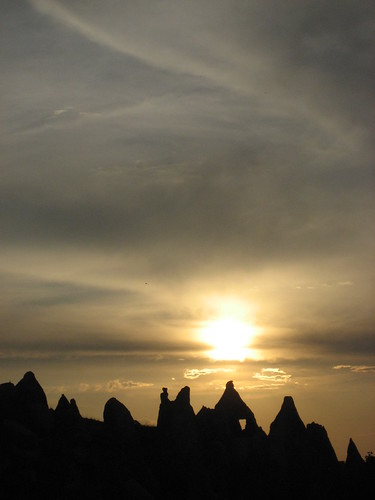
After a week, my friends at the hostel started asking me if I was ever planning on actually doing anything while in Goreme. Apparently exploring and sleeping weren't enough for them. To their credit, there was a lot to do in the region, and time had come to get out there and really sightsee. The Cappadocia region is very spread out — about 60 miles across — so I rented a motor-scooter for 24 hours, strapped on my helmet, and hit the road.
Speeding along a few miles outside Goreme, I made a couple of wrong turns and a huge family flagged me down to offer help. They were a group of about twenty Georgian Turk immigrants, and they were eager to feed me a hearty lunch of delicious homecooked multi-ethnic cuisine. The family was insanely nice, and gave me my first glimpse of the excellent hospitality of Turksish people away from touristy areas. Here I am with the family's male half:
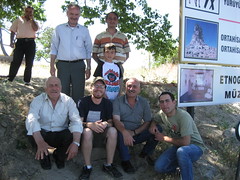
I continued on toward the town of Urgup, where I stopped in at the Turasan Winery to see if I could score some free wine. The Cappadocia region has a long wine-making tradition, and apparently cranks out some of the best available Turkish wine. As I walked into the winery, the guy took one look at my disheveled appearance and blurted out, "You can try ONE red and ONE white for free, and anything more costs money." Was I that obvious? I feigned sincere interest and unveiled my arsenal of wine terminology, just to throw a little bit of sass the guy's way. The nose on this is exquisite! And the color! My word! Does anyone else taste a hint of chocolate? I'm getting a hint of chocolate!
After the tasting, I headed down into the quaint center of Urgup, which was quite a bit more upscale than Goreme and had a lot of pleasant cafes and nice restaurants. I stopped in at one place and celebrated its grand opening with the owner. Turkish people are quick to offer tea, and seem to genuinely enjoy conversation with foreigners, even if you don't buy what they're selling (usually lunch or carpets). I continued my look around town, and came across a huge area of hundreds of cave homes carved into the side of a mountain. Amazingly enough, I was the only tourist who seemed to know about it, and I had the place to completely to myself.
As the sun went down, I rode over to the amazing village of Ayvali, a quiet and untouched place with lots of locals who stared at me as I walked through town. Like in most parts of Turkey, the worlds of women and men were clearly divided. Headscarfed women sat in small groups out on the front stoops of their homes chatting, knitting and gossiping, while the men took their usual place at the teahouse, gulping down sugary tea and playing passionate games of backgammon or dominoes. The kids were thrilled to see me, and excited to have their photos taken. I continued on my bike winding through the rocky countryside to Mustafapasa, a quiet little town with a lot of delicate old Greek houses. Here are some shots from my day's journey:

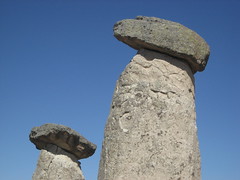
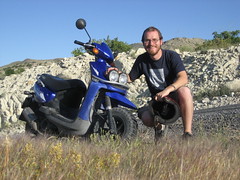
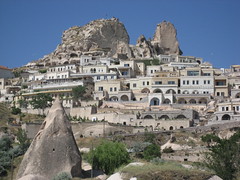
The following morning, I used my last few hours of my motor-scooter rental and made the long drive about 30 miles south to Derinkuyu, a town famous for its labarynth underground city. The city at Derinkuyu is one of a number of underground cities spread throughout Cappadocia, inhabited for over 4000 years. Once inside, a nice local student offered to lead me around the caves so he could practice his English. He was pretty confident with his second language, which was odd because it seemed like he had never heard English before, let alone spoken it. The tour went something like this:
Him: Chooch da pote ayim.
Me: Oh... this room was a... uhh... hmm...
Him: Chooch! Chooch!
Me: Yeah, yeah... a... chooch.
Him: Yes, yes! Ha ha, chooch!
Me: (sees sign that says "church") Oh, a church!
Him: No! Chooch! Chooch!
Me: Right... chooch... sorry.
In addition to the chooch, there was also an underground school, winery, kitchen, graveyard, wells, impressive ventilation shafts, rainwater storage tanks, and tons of cave homes. The underground city went eight stories deep through a series of labyrinths and rooms, and made for a very cool and memorable visit. I parted ways with my wacky guide, who had trouble understanding the tricky English expression "bye bye," and explored the town a bit. Most visitors to Derinkuyu make a quick stop at the underground city on tours, but with the luxury of having my own wheels, I lingered around town and stumbled upon this dusty little outdoor market where I got a lot of curious stares and little kids venturing up to say hello.
Time came to leave the comforts of Cappadocia and head a bit more off-the-beaten-track into Eastern Turkey. After an overnight bus southeast toward the Syrian border, I arrived in the town of Sanliurfa at dawn, and to be honest, I was freaking out. It was 95 degrees already at 6:30 am. I was in one of the most conservative and Islamic cities in Turkey. The hot sun slammed into my face as I walked from the dusty bus station toward what I hoped was the town center. I didn't speak the language. I was alone. For one of the first times on my trip, I felt like I was in over my head. What the hell was I thinking?
My first day in Sanliurfa was rough. In Western Turkey, there are backpackers aplenty, and even when you spend the day out alone in the middle of nowhere, it is comforting to know that the comfy hostel awaits you each night. In Sanliurfa, I checked into a ratty and smoke-filled business hotel, where the disgruntled owner looked angrily at my passport, blew smoke in my face, and muttered, "Ooooooossssaaa." I figured that it wasn't wise to mention that USA is an acronym, not a word.
After a day, I quickly warmed up to Sanliurfa and I started to really love the place. The town is an important holy site for Muslims and Christians alike, and it was interesting to see the headscarfed locals mix with the Iranian pilgrims, who peered out at the town from the shelter of their black burkas. I visited the cave where Biblical Abraham was born, explored the town castle, and dropped some fish food into a pool to fatten up the holy carp outside the 13th century mosque, which are locally considered to be sacred. In the center of town is a great little courtyard, which formerly served as a caravanserai, the places where people trekking along the Silk Road route would stop for the night or engage in trade. Now, the caravanserai is packed full of old men, doing the only thing old men in Turkey seem to be capable of: sipping down glasses of tea and playing backgammon, cards, or dominoes. I loved the atmosphere in the place, and spent a half-hour there watching the old men's overwhelming passion for their games.

Spread in every direction away from the caravanserai's walls is Sanliurfa's incredible bazaar — the most interesting market I've seen on my whole trip. The winding alleys were piled high with goods for sale, and the air filled with the shouts of vendors advertising sales along with the dull pounding sounds of coppersmiths hammering metal into just the right shape. I held my breath as I passed the stench which poured out of butcher shops where freshly-killed sheep dangled from hooks, and piles of animal hearts were piled up as casually as if they were fruit. I was walking down an alley when I heard a cart rolling along, which turned out to be piled with bloody carcasses of dead sheep. The cart-rolling guys were so delighted that I wanted to take their picture, they invited me into their home and showed me stacks upon stacks of bloody fur they had laying around. It was like walking around in a vegetarian's worst nightmare. Here are the guys wheeling their carcass cart:
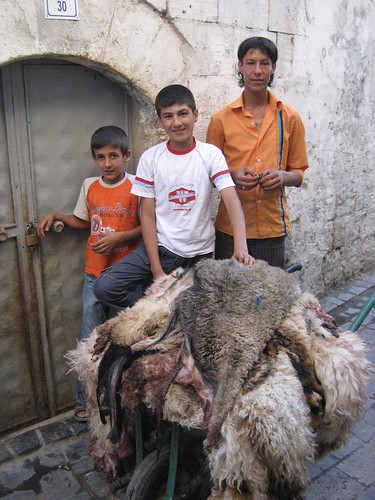
Interestingly, Sanliurfa directly translates as "Glorious Urfa," which became the town's name in 1984 after their rival town Antep changed its name to Heroic Antep, and Urfa upped the ante out of pride. I'm waiting around for the inevitable next stage: Extremely Heroic Antep and Unbelievably Glorious Urfa.
Sanliurfa is a town inhabited mostly by Kurds, the largest minority group in Turkey, numbering 15 million people within Turkey alone, mostly in the southeastern part of the country. A large chunk of the other Kurdish people are found in northern Iraq, which is the most stable and independent area of the post-Saddam era. As an American, I wasn't sure how I would be perceived in a heavily Kurdish city. On one hand, the War in Iraq and the Bush administration have destabilized an already unstable region, and have deeply alienated Muslim people, Kurds included. On the other hand, the US has provided one of the only chances at establishing an independent country of Kurdistan, something that many Kurds have wanted desperately since their people were divided among Iran, Iraq, and Turkey. The Kurds in Sanliurfa were eager to speak to me about the situation. Some loved America. Some hated America. Most despised George W. Bush, yet most supported the US-triggered fall of Saddam Hussein, who freely massacred Kurds. Some spoke out against US imperialism, yet simultaneously supported the War in Iraq. Some felt united wıth Turks and wanted to remain a part Turkey, and some demanded an independent state. The mixed feelings were understandable, although a bit confusing. To add to the complexity, the main organization fighting — sometimes very violently — to make an independent Kurdistan a reality is the PKK, a group labeled by the United States and other countries as a terrorist organization. Many Kurds carefully tread on a thin line, not publicly supporting the PKK for fear of imprisonment, yet quietly voicing their interest in an independent Kurdistan. It will be very interesting to see how the Kurd situation develops in the coming years as both Turkey and the US elect new leaders. Unfortunately for the Kurds, they have little control over their own destiny.
I ganged up with the few other tourists in Sanliurfa for a two-day trip to nearby Mt. Nemrut, one of Eastern Turkey's best sights. In my group was Wolf, a mammoth German man who looked like Arnold Schwarzenegger's father, who was going on this exact same tour for the 12th time in eight years. With so many amazing places to see in the world, I'm not sure why anyone would want to beat a dead horse to such an insane extent, but to each his own, I suppose. There was also Patrick, an inspiring Spaniard who is spending nearly three years traveling completely around the world by bicycle, raising money for community youth programs via his website. When he returns home to Barcelona, he plans to tour schools with an video of his journeys, to educate and inspire kids about the world around them.
Along with a group of others, we piled in a van and sped toward Mt. Nemrut, making quick stops at other interesting sights along the way. Our driver's broken-English and enthusiasm was hilarious — he constantly referred to everyone in our group as "my uncle!" We gazed in wonder at the enormous Attaturk Dam, one of the largest in the world, then were off to the famous left parenthesis of the Mesopotamian fertile crescent, the Euphrates River, where our driver encouraged us to take a plunge in its ice cold waters. 1-2-3-4! Jumping time! My Uncle! We stopped by a few other archaeological sites and caves, the most interesting of which was the beautiful Septimus Severus Bridge, built in 200 AD. As the sun began to go down, the van pushed uphill toward the summit of Mt. Nemerut, while our crazy driver insisted we take part in his constant singing:
Mt. Nemrut is famous for its nine-foot-tall stone heads, which were commisioned by King Antiochus as a monument to his greatness. His large bust sits alongside various Greek and Persian gods, and was built as a pyramid-style burial mound made to awe his followers, and help ensure his status as an all-powerful god for the rest of eternity. Unfortunately for Antiochus, his followers all died out, the world moved on from paganism to the Judeo-Christian tradition, and the statues of Mt. Nemrut were forgotten until they were rediscovered in the late 1800s by German archaeologists. Our group enjoyed watching the setting sun shine onto the statues from the from the insanely windy summit of the mountain. We returned again the next morning for an even more windy sunrise, but it was definitely worth the great views.
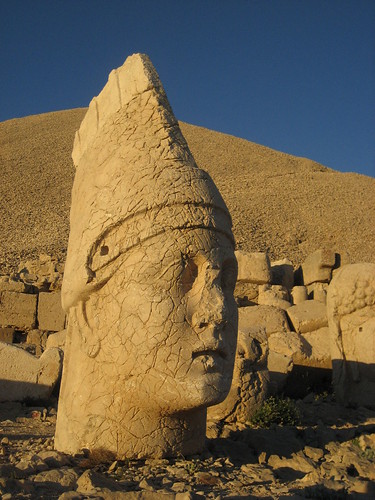
Back in Sanliurfa, I went on a day trip south to Harran, an extremely old town located just a few miles away from the Syrian border. Like many places in Turkey, Harran is an extremely old town. How old? Well, the town gets name-dropped in the Book of Genesis, right there alongside the creation of earth and everything. The dusty little village retains a very Biblical feel, with its unique beehive-shaped mud houses scattered throughout town. There's also some interesting ruins of another caravanserai, and one of the world's first universities. Here is one of the refurbished beehive house complexes:
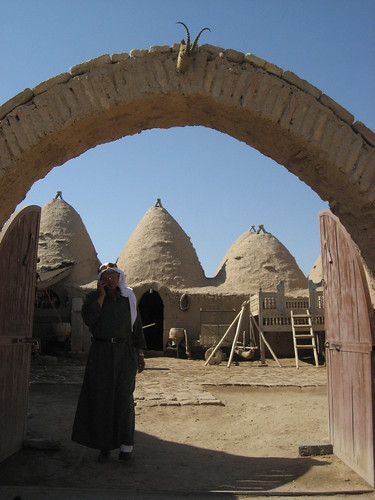
I finally left the Sanliurfa area, on a night bus across the Kurdish part of the country. A remarkably annoying guy sat next to me on the trip so he could practice his painfully broken-English, and was driving me completely insane asking me questions until about 3:00 am, when we pulled into a town called Batman — seriously — where he lived. I was excited about both the town's name and that the guy was leaving, but his unintentionally hilarious farewell speech was the icing on the cake: "I... am.... Batman." Awesome.
Despite its perfect setting between the waters of Lake Van and the large mountains which rise above town, the town of Van is a gritty and gray city, and definitely won't go down as one of the nicer places I've visited on the trip. If a competition was held to find the city's most pathetic eyesore of a building, it would be a thousand-way tie for first place. With that said, on street level Van did have a fair bit of charm, mostly thanks to the large University which packs the town with young people and cheap cafes. My favorite part of town was the great Breakfast Street, where hundreds of people gathered to enjoy a nice outdoor feast each morning at one of about a dozen eateries. I had a really nice group of university professors from Western Turkey invite me over to their table for food and conversation, which made me feel at home.
Another morning I caught a minibus across the shimmering turquoise shores of massive Lake Van to a boat dock where I hopped aboard a short ferry to Akdamar Island. The island is home to a partially-ruined Armenian church, which had some nice interior fresco paintings and a ghostly atmosphere. The outside had interesting carvings of stories from the Bible — my favorite was Jonah in the belly of a whale, which was depicted as a fish with a dog head, since the artists had never seen a whale before and didn't know what one looked like. I also paid a visit to Van's sprawling castle, which towers over the farmhouses on the outskirts of town.

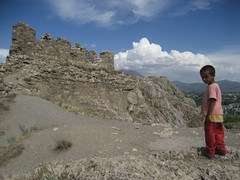
We drove north from Van — in a van — along the Turkish-Iranian border, and I was distracted from the gorgeous rocky scenery by the occasional military checkpoint, where gray-uniformed soldiers would give the van a quick search before allowing us to continue. At one checkpoint, festive flowerpots sat atop barricades as if trying to compensate for the inevitable buzz kill provided by the machine guns and tanks. I was the only foreigner in the van, and the troops gave my passport quizzical glances, but apart from a light frisking at one checkpoint, I made it through without any hassle to Dogubayazit.
The little town of Dogubayazit is dominated by the epic-looking Mount Ararat, which served as the resting place of Noah's Ark in the Bible. You may remember the story: God decided to flood the earth, so he asked Noah to collect two of each animal in the world — all two million species known to scientists today — and bring them to a boat which Noah built to house the creatures. It must have been one hell of a big boat. All the animals took a break from the food chain for 40 days and 40 nights, and everything worked out in the end when Noah's ark came to rest on the top of Mount Ararat. To be fair, most Christians view the story as a symbolic one, rather than a literal historical event. Still, there are several groups in the area who claim they have found the remains of the actual boat used by Noah. Either way, the soaring views of the highest peak in Turkey from Dogubayazit were seriously awe-inspiring.

Just outside of town on a secluded hillside is the Ishak Pasa Palace, an amazing castle built in the 17th century. With so many ruined palaces and castles throughout Turkey, it was great to see one that was still largely intact. The Kurdish palace was complete with several sunlit courtyards, dungeon-like basement rooms for servants, a series of simple and elegant bedrooms, a gorgeous dining room with lots of carved-stone patterns, and its very own mosque. I was really impressed, and the palace definitely one of my favorite places I visited in Turkey.
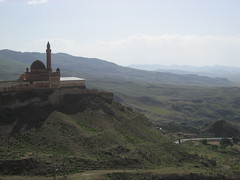
Heading toward the country of Georgia, I left Dogubayazit and stopped over in the town of Kars for a few days. I arrived in Kars at dusk, and the gritty town seemed strangely familiar. It reminded me almost exactly of Hill Valley in Back to the Future 2, when time skewed into a tangent and created an alternate, evil 1985. Everything in town seemed like it was falling apart. A dark cloud hung overhead. Fiery piles of trash burned on the streets unattended. Scruffy taxi drivers tried to lift my backpack into their rickety cars. A filthy homeless woman sprawled out on the floor of an ATM booth on a bed of trash and old newspapers. A rag-tag gang of kids scrambled up and tried to shine my shoes. My guidebook described Kars as "a bit rough around the edges," and I had apparently just arrived at the edges.
I checked into a hotel with a Turkish-speaking German named Ole, and we headed out together to explore Kars, which turned out to be a little bit more pleasant than I had first expected. Ole and I were invited into the campaign headquarters of a local political party, who were gearing up for the upcoming nationwide election on July 22nd. We shook hands and spoke to a few of the sharply-dressed candidates over tea, and I was able to relay questions through Ole about the future of Turkey's political scene, which was a fun experience.
The following day, we hopped in a car and went east to the edge of Turkey to Ani, a huge long-abandoned town which sits on the Armenian border. Ani was a primary stopover on the east-west trade rout of the Silk Road, and was a significant piece of many empires which swept through and conquered the area over the course of a thousand years. The town eventually ended up in the hands of the nomadic Mongols, who basically left the town to rot and most of the buildings crumbled. All that remains today is the gigantic old city wall, and a dozen gorgeous churches and mosques built by the various people who inhabited Ani. My favorite moment was in one of the ruined churches, when an Armenian tourist began to sing a beautifully haunting Armenian song giving the place a really eerie feel.
(video coming soon)
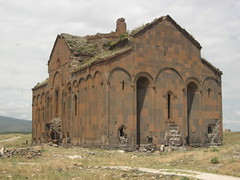
From Kars, I headed into the little-known country of Georgia for about a week, which I'll cover in my next update. I'm back in Istanbul now, and I've spent all morning fighting with the computer, and anticipating the arrival of my friend Matt Coyle who will be arriving here in Istanbul any minute now. We don't have plans yet, but we'll likely head into Eastern Europe for a while.
Thanks for reading this ridiculously long post! I hope you are all well.
Ryan!
Photos updated: Istanbul, Selcuk, Ephesus, Pammukale, Fethiye, Cappadocia, Sanliurfa, Mt. Nemerut